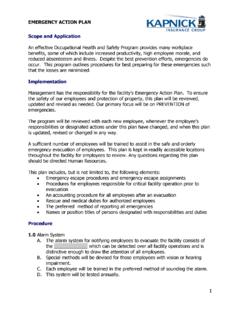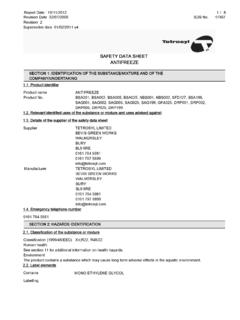Transcription of Conforms to HazCom 2012/United States SAFETY DATA SHEET
1 AMGFlex (IAQ), HPD Flex Duct (Commercial)Flexible product identifierOther means of identificationProduct typeEmergency telephone number (with hours of operation)Section 1. Identification::::Supplier's details:Identified usesAMGFlex (IAQ), HPD Flex Duct (Commercial) SAFETY DATA SHEETC onforms to HazCom 2012/United StatesQuietFlex Manufacturing Company Brittmoore , Texas 77041 Tel : (713) 849-2163 Toll Free : 1-877-694-3669 Fax : (713) 849-0753 Web site: : +1-613-996-6666 or *666 (cellular)CHEMTREC, : 1-800-424-9300 International: +1-703-527-388724/7 Flexible Duct for the residential and manufactured home marketplace for the HVAC code:Not code:Not 2. Hazards identificationNot of the substance or mixture:Signal word:No signal statements:No known significant effects or critical statementsPrevention:Not :Not :Not :Not label elementsOSHA/HCS status:While this material is not considered hazardous by the OSHA Hazard Communication Standard (29 CFR ), this SDS contains valuable information critical to the safe handling and proper use of the product.
2 This SDS should be retained and available for employees and other users of this product.:None not otherwise classified (HNOC)1/10 Tel : +1-888-GHS-7769 (447-7769) / +1-450-GHS-7767 (447-7767) (IAQ), HPD Flex Duct (Commercial)Section 3. Composition/information on ingredientsAntimony - 1 Ingredient nameCAS number%There are no additional ingredients present which, within the current knowledge of the supplier and in the concentrations applicable, are classified as hazardous to health or the environment and hence require reporting in this means of identification:Flexible DuctSubstance/mixtureCAS number/other identifiers:Occupational exposure limits, if available, are listed in Section concentration shown as a range is to protect confidentiality or is due to batch trioxide is an ingredient found in the adhesive used to CONSTRUCT the outer jacket of our Flexible Duct products.
3 Antimony trioxide and other glue chemicals are APPLIED between TWO IMPERVIOUS PET films during the curing process. The final product is the outer jacket, a solid, which will not cause exposure to Antimony Trioxide. The adhesive ENCAPSULATED BETWEEN THE FILMS BECOMES A CURED SOLID AND PROVIDES NO PATH FOR OCCUPATIONAL EXPOSURE TO ANTIMONY out mouth with water. Remove victim to fresh air and keep at rest in a position comfortable for breathing. If material has been swallowed and the exposed person is conscious, give small quantities of water to drink. Do not induce vomiting unless directed to do so by medical personnel. Get medical attention if symptoms flush eyes with plenty of water, occasionally lifting the upper and lower eyelids.
4 Check for and remove any contact lenses. Get medical attention if irritation contaminated skin with plenty of water. Get medical attention if symptoms victim to fresh air and keep at rest in a position comfortable for breathing. Get medical attention if symptoms occur. In case of inhalation of decomposition products in a fire, symptoms may be delayed. The exposed person may need to be kept under medical surveillance for 48 4. First aid measuresEye contactSkin contactInhalationIngestion::::Descriptio n of necessary first aid measuresMost important symptoms/effects, acute and delayedInhalation:Dusts and fibers form of this product may cause temporary mechanical irritation to the nose, throat and respiratory of this product is unlikely; however, ingestion may cause gastrointestinal irritation.
5 :IngestionSkin contact:Dusts and fibers form of this product may cause temporary mechanical irritation and redness to the and fibers form of this product may cause temporary mechanical irritation to the eyes.:Eye contactOver-exposure signs/symptomsSkin contactIngestionInhalationNo known significant effects or critical known significant effects or critical known significant effects or critical hazards.:::Eye contact:No known significant effects or critical acute health effects2/10 Tel : +1-888-GHS-7769 (447-7769) / +1-450-GHS-7767 (447-7767) (IAQ), HPD Flex Duct (Commercial)Section 4. First aid measuresProtection of first-aiders:No special protection is to physician:In case of inhalation of decomposition products in a fire, symptoms may be exposed person may need to be kept under medical surveillance for 48 treatments:No specific toxicological information (Section 11)Indication of immediate medical attention and special treatment needed, if necessarySection 5.
6 Fire-fighting measuresNo special measures are thermal decomposition productsSpecific hazards arising from the chemicalDecomposition products may include the following materials: carbon dioxide, carbon monoxide, nitrogen oxides, organic acids, aldehydes and products may be combusted by remaining in contact with flame. If flame source is stationary these products will shrink away and self-extinguish. If these products remain in contact with a flame they may continue to burn slowly, dropping flaming liquid which may spread the should wear appropriate protective equipment and self-contained breathing apparatus (SCBA) with a full face-piece operated in positive pressure protective equipment for fire-fightersUse dry chemical, CO2, water spray (fog) or media:::None extinguishing media:Unsuitable extinguishing media:Special protective actions for fire-fighters:Section 6.
7 Accidental release measuresEnvironmental precautionsPersonal precautions, protective equipment and emergency procedures::Put on appropriate personal protective up large pieces and dispose as listed in Section 13 of this and materials for containment and cleaning upFor non-emergency personnelFor emergency responders:If specialized clothing is required to deal with the spillage, take note of any information in Section 8 on suitable and unsuitable materials. See also the information in "For non-emergency personnel".Pick up large pieces. Vacuum dusts and loose fibers. If sweeping is necessary, use dust suppressant such as water. Do not dry sweep dust. Never use compressed air for clean-up. Dispose of via a licensed waste disposal contractor.
8 Note: see Section 1 for emergency contact information and Section 13 for waste disposal.:Spill3/10 Tel : +1-888-GHS-7769 (447-7769) / +1-450-GHS-7767 (447-7767) (IAQ), HPD Flex Duct (Commercial)Section 7. Handling and storageAdvice on general occupational hygieneConditions for safe storage,including any incompatibilitiesEating, drinking and smoking should be prohibited in areas where this material is handled, stored and processed. Workers should wash hands and face before eating,drinking and smoking. See also Section 8 for additional information on hygiene in accordance with local regulations. Store in original container protected from direct sunlight in a dry, cool and well-ventilated area, away from incompatible materials (see Section 10) and food and drink.
9 Keep in original packaging until ready for use.::Protective measuresPut on appropriate personal protective equipment (see Section 8).:Precautions for safe handling:Storage should be in accordance with packaging directions, if any. Material should be stored in a dry place and kept in its original packaging until trioxideACGIH TLV (United States , 3/2015). TWA: mg/m , (as Sb) 8 PEL (United States , 2/2013). TWA: mg/m , (as Sb) 8 REL (United States , 10/2013). TWA: mg/m , (as Sb) 10 PEL 1989 (United States , 3/1989). TWA: mg/m , (as Sb) 8 8. Exposure controls/personal protectionIngredient nameExposure limitsHand protectionCotton or leather gloves should be worn to protect against mechanical abrasion. Use caution when handling the inner Core as the taped ends may come loose during handling exposing the wire used to construct the inner eyewear complying with an approved standard should be used when a risk assessment indicates this is necessary to avoid exposure to possible insulation protection::Body protectionWear a cap, a loose-fitting long sleeved shirt and long pants to protect skin from mechanical irritation.
10 Exposed skin areas should be washed with soap and water after handling or working with fiberglass.:Environmental exposure controls:Pick up solid pieces and dispose of as listed in Section engineering controls:Good general ventilation should be sufficient to control worker exposure to airborne hands, forearms and face thoroughly after handling products, before eating,smoking and using the lavatory and at the end of the working period. Ensure that eyewash stations and SAFETY showers are close to the workstation measures:Control parametersIndividual protection measuresOccupational exposure limitsSkin protectionThe Occupational SAFETY and Health Administration (OSHA) have not adopted specific exposure standards for fiber glass.







